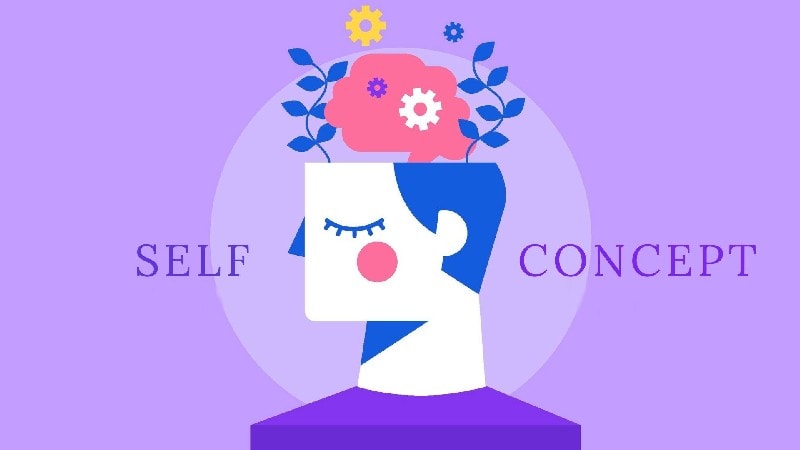
What Are the Different Components of Self-Concept?

Self-concept is the understanding and perception we have of ourselves It encompasses our beliefs, values, abilities, and personality traits Rogers identified three components of self-concept: self-image, self-esteem, and ideal self The development of self-concept is malleable and can change throughout our lifetime Lewis also contributed to the concept of self, emphasizing the importance of social comparison in shaping our self-concept
Self-concept refers to an individual's perception and understanding of themselves, encompassing their personal, social, and physical identity, as well as their behavior and unique characteristics. While self-concept is primarily developed during childhood and adolescence, it is an ongoing process that evolves as individuals gain more insight into themselves over time. Essentially, self-concept can be seen as a framework of knowledge that includes an awareness of one's internal thoughts and feelings, as well as their external actions and reactions.
Collecting and understanding information about oneself is made possible through self-awareness. This knowledge forms the foundation of one's self-concept, which evolves as individuals broaden their perspectives on their identity. Although previously viewed as a singular and unchanging construct, modern scholars now recognize the self-concept as a dynamic and constantly evolving aspect of one's personality.
They believe that the structure is impacted by both the motivations of individuals and the social situation equally.
There are six main domains which are related to self-concept
Competence: the ability to meet the basic needs or requirements
Social: which is the ability to interact with other people
Affect: which is the awareness of the emotional state
Physical: which are the feelings related to looks, health, physical condition and overall appearance
Family: is how well we function in a family unit
Academic: determines the level of success in school
Rogers components of Self-concept
Carl Rogers, who was one of the founders of humanistic psychology, suggested that the self-concept often includes three major components. These components are as follows:
1. Self Image
Our self-image is our personal perception of ourselves, encompassing our physical features, social roles, and personality traits such as being serious, jolly, outgoing, introverted, or kind. However, this perception may not always align with reality, as some individuals may have an inflated sense of self for certain characteristics.
The magnified perspectives can either be favorable or unfavorable, leading to a person having a positive outlook on certain aspects of themselves while having a negative outlook on others. The fundamental inquiry concerning self-image is, "who am I?" The response to this inquiry typically encompasses four categories of replies:
Appearance and social status both play a crucial role in shaping our identities. Our physical characteristics, such as eye color, hair color, and height, are just one aspect of how we are perceived by others. Additionally, the roles we play in society, whether as a spouse, student, or athlete, shape our behavior and expectations in various situations. Understanding these roles helps us better recognize ourselves and what is expected of us in different social contexts.
Fragment 12 rewritten: Personal traits are among the characteristics we use to describe ourselves. These can be anything from generosity to anger, impulsivity to excessive worrying. Additionally, we may make more abstract or existential statements about our identity, such as identifying as a human being, a child of the universe, or a spiritual being.
2. Self-esteem
Our self-esteem can also be negatively impacted when we compare ourselves to others and find that we are lacking in certain areas. Additionally, negative responses from others can also lower our self-esteem. Ultimately, our self-esteem is a complex and dynamic construct that is influenced by various internal and external factors.
However, if we constantly compare ourselves to others and feel inferior in certain areas, our self-esteem can take a hit. This can result in negative self-perception, feelings of inadequacy, and a lack of confidence in ourselves. It's possible to have high self-esteem in some areas while struggling with low self-esteem in others. When we focus on our strengths and accomplishments, rather than comparing ourselves to others, we can maintain a positive self-image and outlook on life.
Low self-esteem can result in a lack of confidence, a negative outlook on life, a desire for external acceptance, and a constant preoccupation with others' opinions. Self-esteem can be assessed through various methods, including the Thematic Apperception Test (TAT).
Factors which affect self-esteem:
1. The reaction of other people
Our perception of ourselves is often shaped by how others treat us. When we receive admiration and flattery, and others actively seek out our company and listen to our opinions, we tend to view ourselves positively. However, when we are avoided and neglected, and others speak negatively about us, our self-image can become negative.
Content rewritten:
Comparing ourselves to others can have a significant impact on our self-image. When we perceive others as being more successful, prosperous, happier, and better looking than ourselves, we may develop a negative self-image. On the other hand, if we perceive others as being less successful and less accomplished in almost every aspect of life, we may be more likely to build a positive self-image.
Content: Certain social roles such as being a pilot, doctor, or writer are often associated with prestige and can contribute to a person's sense of self-worth. However, there are also roles that carry negative stigmas, such as being a mental hospital patient, prisoner, unemployed person, or trash collector.
We don't simply follow rules because they exist; rather, they become intertwined with our identity. We find ourselves identifying with the positions we hold, the roles we play, and the groups we belong to.
3. Ideal self
Our ideal self represents the version of ourselves that we aspire to become. It is often different from our current self-image, and the gap between the two can have a negative impact on our self-esteem.
According to Carl Rogers, one's self-image and ideal self can either align or be in conflict with each other. When there is congruence between the two, it means that they share a lot of similarities. Although it may be challenging, it is possible to attain a perfect congruence.
The extent of congruence directly impacts the level of self-actualization achieved. Conversely, when there is incongruence between the ideal self and the actual self, it creates a discrepancy between one's experiences and their self-perception. This leads to internal confusion, hindering the process of self-actualization and causing cognitive dissonance.
Congruence and Incongruence
The idea of self can sometimes be out of sync with reality. Some students may perceive themselves as excellent academically, but their grades may indicate otherwise. Psychologist Carl Rogers introduced the terms "congruence" and "incongruence" to describe the extent to which our self-concept aligns with reality. Rogers suggested that the development of congruence begins in childhood when parents set conditions for their love and affection. If a child only receives love when they meet certain expectations, such as achieving good grades, it can lead to incongruence. Conversely, unconditional love can foster congruence.
Children who experience such unconditional love may not need to distort their memories so that they have to believe that people will accept and love them as they are.
Development of self-concept
From a young age, individuals begin to develop their self-concept, a process that continues throughout their lifetime. However, it is during early childhood that the self-concept experiences the most significant growth. By the age of two, children begin to differentiate themselves from others, and by three or four, they begin to understand their uniqueness and separateness from others. At this stage, a child's self-image is primarily based on physical characteristics and concrete details they have been told about themselves.
By the age of six, children become increasingly aware of their own capabilities and are able to express their wants and needs. They also begin to assert themselves and establish their identities within their social circles. As they approach 11 years old, children start to compare themselves to others and consider how they are perceived by their peers. During this stage, children tend to describe themselves in more abstract terms, focusing on their abilities rather than just physical attributes. They also recognize that their traits and qualities exist along a spectrum rather than being absolute.
During childhood, children develop an ideal self-image that may include aspirations to become an athlete, astronaut, or doctor. However, adolescence is a critical period for the development of self-concept, which serves as the foundation for one's sense of self throughout life. During this time, individuals experiment with various roles, identities, and personas as they navigate the complexities of growing up.
Malleable concept of self
Adolescents tend to base their self-concept on their achievements in areas they value highly. When they receive recognition and achieve success, it can lead to improved self-esteem and a healthier sense of self.
Our concept of self is highly adaptable, allowing us to selectively define ourselves based on the situation we find ourselves in. This fluidity is influenced by both the social context and feedback we receive from our environment, resulting in certain aspects of ourselves being more prominent than others. For instance, a 22-year-old may feel acutely aware of their youth when surrounded by older individuals, but not when among peers of the same age.
By prompting individuals to recollect instances of specific behaviors, the notion of self can be altered. Individuals are capable of recalling times when they exerted significant effort, as well as instances where they were less productive. Often, individuals identify with one of these opposing traits, perceiving themselves as either hardworking or lazy depending on their mindset.
Lewis’s concept of self
The psychologist Lewis suggested in 1990 that the development of self-concept has two significant aspects.
These two aspects are as follows:
The concept of the existential self emerges when a child becomes aware that they are a distinct individual from others and that their existence persists over time and space. Lewis notes that this realization can occur as early as two to three months of age and is a natural part of the child's relationship with the world around them.
For example, the child smiles when someone smiles back, and someone smiles back when the child smiles at them or the child touches a mobile and sees it moving.
2. The Categorical Self
As a child realizes their individuality and existence as a living organism, they also come to understand that they are a part of the world as an object. Just like other objects, people included, they have properties that can be experienced, such as size, texture, and more. This realization helps the child develop a sense of self-awareness and understand that they too have unique qualities that make them an object in the world.
As individuals grow and develop, their sense of self expands beyond basic physical attributes like gender and age, to include more complex elements such as personality traits and social perception. This evolution is evident in early childhood, where children often define themselves by tangible characteristics like height or color. However, as they mature, their self-description becomes more nuanced and includes factors like how they are perceived by others and how they measure up in comparison to their peers.










